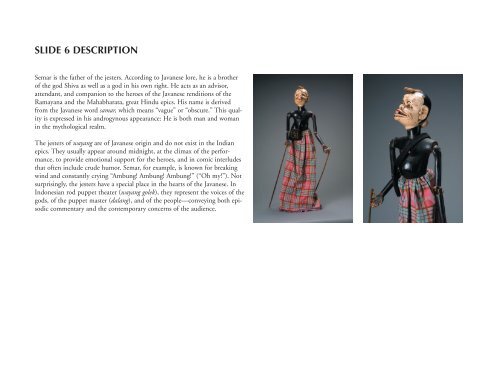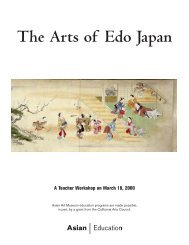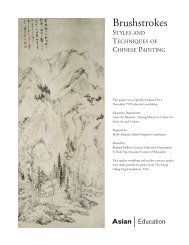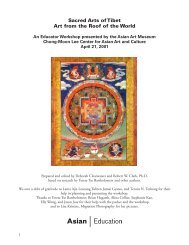Wayang Golek Slide Descriptions (PDF) - Asian Art Museum ...
Wayang Golek Slide Descriptions (PDF) - Asian Art Museum ...
Wayang Golek Slide Descriptions (PDF) - Asian Art Museum ...
You also want an ePaper? Increase the reach of your titles
YUMPU automatically turns print PDFs into web optimized ePapers that Google loves.
SLIDE 6 DESCRIPTION<br />
Semar is the father of the jesters. According to Javanese lore, he is a brother<br />
of the god Shiva as well as a god in his own right. He acts as an advisor,<br />
attendant, and companion to the heroes of the Javanese renditions of the<br />
Ramayana and the Mahabharata, great Hindu epics. His name is derived<br />
from the Javanese word samar, which means “vague” or “obscure.” This quality<br />
is expressed in his androgynous appearance: He is both man and woman<br />
in the mythological realm.<br />
The jesters of wayang are of Javanese origin and do not exist in the Indian<br />
epics. They usually appear around midnight, at the climax of the performance,<br />
to provide emotional support for the heroes, and in comic interludes<br />
that often include crude humor. Semar, for example, is known for breaking<br />
wind and constantly crying “Ambung! Ambung! Ambung!” (“Oh my!”). Not<br />
surprisingly, the jesters have a special place in the hearts of the Javanese. In<br />
Indonesian rod puppet theater (wayang golek), they represent the voices of the<br />
gods, of the puppet master (dalang), and of the people—conveying both episodic<br />
commentary and the contemporary concerns of the audience.
















